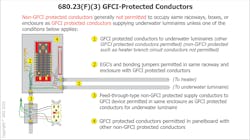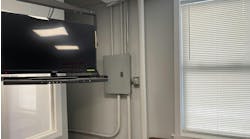Common Code Violations with Swimming Pools and Similar Installations
As summer kicks off, it’s a good time to examine some of the most overlooked and common Code violations inspectors come across when inspecting swimming pools and similar aquatic environments. The following six items are worth keeping in mind when working at these types of locations.
1. Equipotential bonding grid. The requirements outlined in Sec. 680.26 of the National Electrical Code (NEC) are perhaps one of the most misinterpreted, misunderstood sections in the entire NEC. This misinterpretation is not limited to the installer. Unfortunately, it is equally shared by the enforcement community as well.
When it comes to the equipotential bonding grid, one of the best things to remember is that there are two distinct components to the permanently installed pool structure. There is the conductive pool shell (belly steel) and the perimeter surface (deck steel). These two distinctive parts have different bonding requirements and need to be treated differently (i.e., not as one structural component) [see Sec. 680.26(B)(1) and (B)(2) for details].
Another point to keep in mind is the objective of bonding (i.e., connecting to each other) versus grounding (i.e., connected to earth). As stated in Sec. 680.26(A), the goal is to put all metal components and conducting objects at the same voltage potential (reduce voltage gradients). You should bond the conductive components identified in Sec. 680.26(B)(1) through (B)(7) together to form an equipotential bonding grid. Our goal is to bond the conductive components together to form the equipotential bonding grid, not to connect these components to earth (grounding).
This large, extremely heavy structural element (known as a permanently installed in-ground swimming pool) does not need our help connecting to the earth. However, it does need our help in connecting together all the various conductive components that make up the structure and working parts of the swimming pool.
2. Overhead and underground wiring methods around pools. Consideration needs to be given to all overhead and underground wiring methods above, below, and around swimming pools and outdoor spas and/to hot tubs. This is particularly true when a new swimming pool is being built at an existing building or structure.
There is a 22.5-ft-tall by 10-ft perimeter around and above a swimming pool that must be kept free of all overhead wiring methods [Sec. 680.9 and Table 680.9(A)], as shown in Fig. 1.
As for underground wiring methods, Sec. 680.11 requires a 5-ft perimeter circumference to be maintained around a swimming pool (unless the wiring is necessary to supply pool equipment, such as an underwater luminaire installed in the pool shell). Burial depths of these underground wiring methods must comply with Table 300.5 [Sec. 680.11(C)].
3. Wiring methods in corrosive environments. A “corrosive environment” (as applied to a swimming pool, spa, or hot tub environment) is defined in Sec. 680.2 as “areas where pool sanitation chemicals are stored, handled, or dispensed, and confined areas under decks adjacent to such areas, as well as areas with circulation pumps, automatic chlorinators, filters, open areas under decks adjacent to or abutting the pool structure, and similar locations.” Swimming pool and spa equipment are often subject to deteriorating chemicals, such as chlorine, especially in equipment rooms or pits. The equipment and wiring methods in these locations are subject to failure due to exposure to these corrosive chemicals. Chlorine and other pool chemicals severely weaken electrical connections and accelerate rust and deterioration of metal parts of electrical pool equipment. The wiring methods in these corrosive surroundings are required to be listed and identified for use in such areas. Rigid metal conduit, intermediate metal conduit, rigid polyvinyl chloride conduit, and reinforced thermosetting resin conduit have been identified as wiring methods that are resistant to the corrosive environment as specified in Sec. 680.14.
4. GFCI-protected conductors for underwater luminaires to be separated from non-GFCI-protected conductors. A little-known and obscure requirement for swimming pool GFCI-protected conductors resides in Sec. 680.23(F)(3). Any conductors installed on the load side of a ground-fault circuit interrupter (GFCI) used to provide protection for underwater luminaires are generally not permitted to occupy raceways, boxes, or enclosures containing other (non-GFCI-protected) conductors, even if the other conductors are for pool-related equipment, such as a pool heater. This requirement makes it clear that conductors that supply pool equipment, such as pool heaters that do not have GFCI protection, cannot be installed in the same conduits and junction and pull boxes with conductors having GFCI protection that supply underwater luminaires (Fig. 2).
Four specific alternatives to this general rule are provided in the Code (permitted in a panelboard, equipment grounding conductors are permitted in the same raceway, boxes, etc.). See Sec.680.23(F)(3) and Fig. 2 for specifics to these alternative permissive rules.
5. Bonding conductor in the vicinity of a double-insulated pool pump motor. Where a double-insulated water pump is installed, a bonding connection to the equipotential bonding grid is not permitted. However, the Code does require the installation of an 8 AWG solid copper bonding conductor that is of sufficient length to make a bonding connection to a future replacement motor if the replacement motor is not a double-insulated type motor. The bonding conductor is to be extended from the equipotential bonding grid to an accessible location in the vicinity of the motor. Where there is no connection between the bonding grid and the equipment grounding conductor for the premises, the bonding conductor is required to be connected to the equipment-grounding conductor of the pump motor circuit. This connection could be made at the motor termination compartment or in a suitable junction box or other enclosure [Sec. 680.26(B)(6)]. A very similar rule exists in Sec. 680.74(B) for bonding at a replacement motor for a double-insulated motor for a hydromassage tub.
6. Convenience receptacle outlet required in the vicinity of a permanently installed pool. For permanently installed pools, at least one 125V, 15A or 20A receptacle must be installed in the vicinity of the pool. This receptacle must be GFCI-protected, placed on a general-purpose branch circuit, and must be located not closer than 6 ft and not farther than 20 ft from the inside wall of the pool. This required receptacle must be located not more than 6½ ft above the same floor, platform, or grade on which the pool is installed. All other receptacles must be located not less than 6 ft from the inside walls of a pool. This required receptacle applies whether the permanently installed pool is constructed at either a new or existing building or structure. All 15A and 20A, 125V receptacles located within 20 ft of the inside walls of a pool must be GFCI-protected as well [Sec. 680.22(A)(1), (A)(3), and (A)(4)].
We have only covered a few of the items that draw the attention of your local authority having jurisdiction (AHJ) when it comes to the inspection of electrical installations at swimming pools. There are several more items we could look at as well. A comprehensive understanding of Art. 680 of the NEC is essential in obtaining compliance of electrical installations in and around the swimming pool environment. Make sure you read and understand all the Code rules pertaining to electrical installations the next time you venture into the aquatic world of swimming pools.
L. Keith Lofland is the director of technical services for IAEI, Richardson, Texas. He represents IAEI as chairman of NFPA’s Code Making Panel (CMP) 7 for the National Electrical Code (NEC), serves on NFPA’s Electrical Section Executive Committee, and is a member of UL’s Electrical Council. He is also the principal author of several IAEI publications, including IAEI’s NEC Analysis of Changes. Prior to his position with the International Office of IAEI, Lofland spent 16 years with the City of Garland (Texas) serving as their chief electrical inspector. He holds a master electrician license from the State of Texas. He can be reached at [email protected].
Inspector Intel articles are provided by the International Association of Electrical Inspectors (IAEI), www.iaei.org, a membership-driven, non-profit association headquartered in Richardson, Texas, that promotes electrical safety throughout the industry by providing education, certification of inspectors, advocacy, partnerships, and expert leadership in electrical codes and standards.





